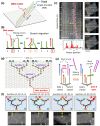DNA Origami Nanomachines
- PMID: 30022011
- PMCID: PMC6099981
- DOI: 10.3390/molecules23071766
DNA Origami Nanomachines
Abstract
DNA can assemble various molecules and nanomaterials in a programmed fashion and is a powerful tool in the nanotechnology and biology research fields. DNA also allows the construction of desired nanoscale structures via the design of DNA sequences. Structural nanotechnology, especially DNA origami, is widely used to design and create functionalized nanostructures and devices. In addition, DNA molecular machines have been created and are operated by specific DNA strands and external stimuli to perform linear, rotational, and reciprocating movements. Furthermore, complicated molecular systems have been created on DNA nanostructures by arranging multiple molecules and molecular machines precisely to mimic biological systems. Currently, DNA nanomachines, such as molecular motors, are operated on DNA nanostructures. Dynamic DNA nanostructures that have a mechanically controllable system have also been developed. In this review, we describe recent research on new DNA nanomachines and nanosystems that were built on designed DNA nanostructures.
Keywords: DNA nanomachine; DNA nanotechnology; DNA origami; high-speed AFM; single-molecule analysis.
Conflict of interest statement
The authors declare no conflicts of interest.
Figures







References
Publication types
MeSH terms
Substances
LinkOut - more resources
Full Text Sources
Other Literature Sources
Miscellaneous

